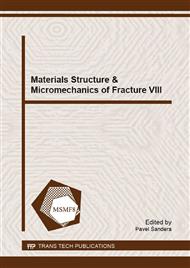p.603
p.607
p.611
p.615
p.619
p.623
p.627
p.631
p.635
Influence of the Microstructure on the Fatigue Cracks Growth in the Joint Zirconium-Steel Made by Explosive Welding
Abstract:
This paper assesses the effect of various values of detonation velocity on the quality of the bond zone. The results of structural, static and fatigue studies were presented for bonds in the initial state. Depending on the applied technological settings of welding, most cases displayed a wavy bond with highly diversified parameters of the wave. High detonation velocities favoured the formation of waves with great height and length and clearly affect the increase in the volume of hard and brittle regions of melt in the bond zone. Increased volume of the melted regions in the bond zone results in the decrease of fatigue resistance and strength properties of the clads.
Info:
Periodical:
Pages:
619-622
Citation:
Online since:
December 2016
Authors:
Price:
Сopyright:
© 2017 Trans Tech Publications Ltd. All Rights Reserved
Share:
Citation:


